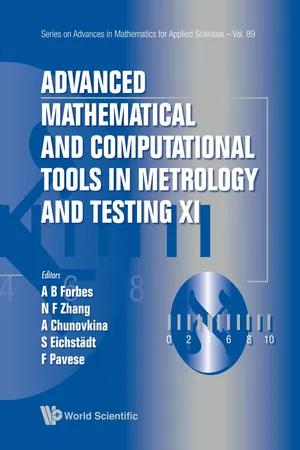
Advanced Mathematical and Computational Tools in Metrology and Testing XI
- 460 pages
- English
- ePUB (mobile friendly)
- Available on iOS & Android
Advanced Mathematical and Computational Tools in Metrology and Testing XI
About This Book
This volume contains original, refereed contributions by researchers from institutions and laboratories across the world that are involved in metrology and testing. They were adapted from presentations made at the eleventh edition of the Advanced Mathematical and Computational Tools in Metrology and Testing conference held at the University of Strathclyde, Glasgow, in September 2017, organized by IMEKO Technical Committee 21, the National Physical Laboratory, UK, and the University of Strathclyde. The papers present new modeling approaches, algorithms and computational methods for analyzing data from metrology systems and for evaluation of the measurement uncertainty, and describe their applications in a wide range of measurement areas.
This volume is useful to all researchers, engineers and practitioners who need to characterize the capabilities of measurement systems and evaluate measurement data. Through the papers written by experts working in leading institutions, it covers the latest computational approaches and describes applications to current measurement challenges in engineering, environment and life sciences.
Contents:
- Analysis of Key Comparisons with Two Reference Standards: Extended Random Effects Meta-Analysis (O Bodnar and C Elster)
- Confirmation of Uncertainties Declared by KC Participants in the Presence of an Outlier (A G Chunovkina and A Stepanov)
- Quantity in Metrology and Mathematics: A General Relation and the Problem (V A Granovskii)
- Bayesian Analysis of an Errors-in-Variables Regression Problem (I Lira and D Grientschnig)
- Triangular Bézier Surface: From Reconstruction to Roughness Parameter Computation (L Pagani and P J Scott)
- On the Classification into Random and Systematic Effects (F Pavese)
- Measurement Models (A Possolo)
- Metrology and Mathematics — Survey on a Dual Pair (K H Ruhm)
- Fundaments of Measurement for Computationally-Intensive Metrology (P J Scott)
- Study of Gear Surface Texture Using Mallat's Scattering Transform (W Sun, S Chrétien, R Hornby, P Cooper, R Frazer and J Zhang)
- The Evaluation of the Uncertainty of Measurements from an Autocorrelated Process (N F Zhang)
- Dynamic Measurement Errors Correction in Sliding Mode Based on a Sensor Model (M N Bizyaev and A S Volosnikov)
- and other papers
Readership: Researchers, graduate students, academics and professionals in metrology.
Key Features:
- Description of state of the art techniques for modeling measurement systems and analyzing measurement data
- Written by researchers active in institutions developing world-leading measurement capabilities
- Provides a multi-disciplinary approach to addressing measurement challenges in a wide range of applications
Frequently asked questions
Information
Advanced Mathematical and Computational Tools in Metrology and Testing XI
Series on Advances in Mathematics for Applied Sciences, Vol. 89
© 2018 World Scientific Publishing Company (pp. 85–118)
Metrology and mathematics — Survey on a dual pair
E-mail: [email protected]
Introduction
1 Assumptions and Preconditions
Table of contents
- Cover Page
- Title Page
- Copyright
- Contents
- Foreword
- Analysis of key comparisons with two reference standards: Extended random effects meta-analysis
- Confirmation of uncertainties declared by KC participants in the presence of an outlier
- Quantity in metrology and mathematics: A general relation and the problem
- Bayesian analysis of an errors-in-variables regression problem
- Triangular Bézier surface: From reconstruction to roughness parameter computation
- On the classification into random and systematic effects
- Measurement models
- Metrology and mathematics — Survey on a dual pair
- Fundaments of measurement for computationally-intensive metrology
- Study of gear surface texture using Mallat’s scattering transform
- The evaluation of the uncertainty of measurements from an autocorrelated process
- Dynamic measurement errors correction in sliding mode based on a sensor model
- The Wiener degradation model with random effects in reliability metrology
- EIV calibration of gas mixture of ethanol in nitrogen
- Models and algorithms for multi-fidelity data
- Uncertainty calculation in the calibration of an infusion pump using the comparison method
- Determination of measurement uncertainty by Monte Carlo simulation
- A generic incremental test data generator for minimax-type fitting in coordinate metrology
- NLLSMH: MCMC software for nonlinear least-squares regression
- Reduced error separating method for pitch calibration on gears
- Mathematical and statistical tools for online NMR spectroscopy in chemical processes
- A new mathematical model to localize a multi-target modular probe for large-volume metrology applications
- Soft sensors to measure somatic sensations and emotions of a humanoid robot
- Bayesian approach to estimation of impulse-radar signal parameters when applied for monitoring of human movements
- Challenging calculations in practical, traceable contact thermometry
- Wald optimal two-sample test for right-censored data
- Measurement
- Sensitivity analysis of a wind measurement filtering technique
- The simulation of Coriolis flowmeter tube movements excited by fluid flow and exterior harmonic force
- Indirect light intensity distribution measurement using image merging
- Towards smart measurement plan using category ontology modelling
- Analysis of a regional metrology organization key comparison: Preliminary consistency check of the linking-laboratory data with the CIPM key comparison reference value
- Stationary increment random functions as a basic model for the Allan variance
- Modelling a quality assurance standard for emission monitoring in order to assess overall uncertainty
- Integrating hyper-parameter uncertainties in a multi-fidelity Bayesian model for the estimation of a probability of failure
- Application of ISO 5725 to evaluate measurement precision of distribution within the lung after intratracheal administration
- Benchmarking rater agreement: Probabilistic versus deterministic approach
- Regularisation of central-difference method when applied for differentiation of measurement data in fall detection systems
- Polynomial estimation of the measurand parameters for samples from non-Gaussian distributions based on higher order statistics
- EIV calibration model of thermocouples
- Modeling and evaluating the distribution of the output quantity in measurement models with copula dependent input quantities
- Bayesian estimation of a polynomial calibration function associated to a flow meter
- Dynamic measurement errors correction adaptive to noises of a sensor
- Author index
- Keyword index